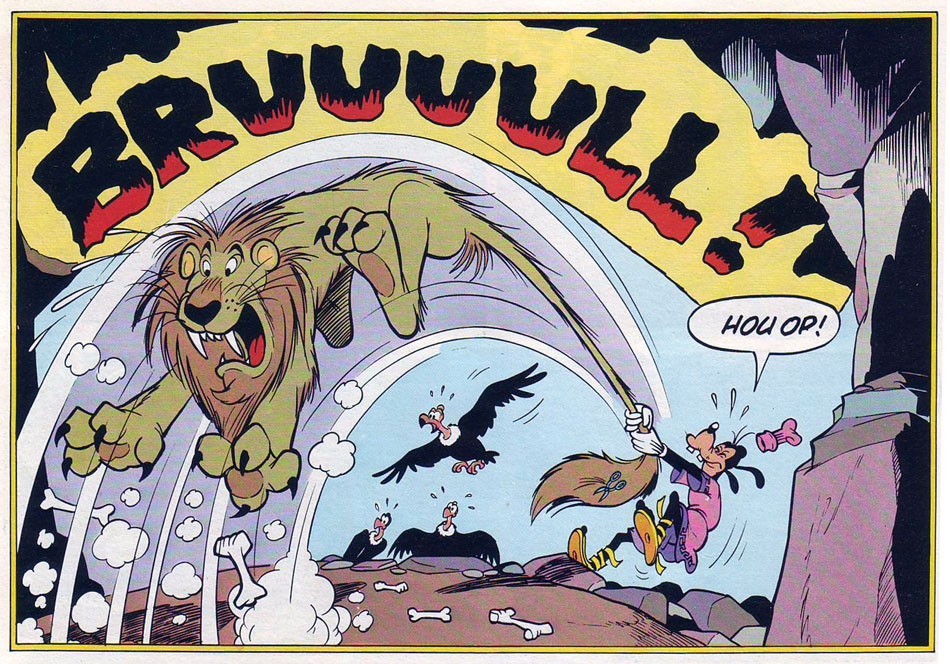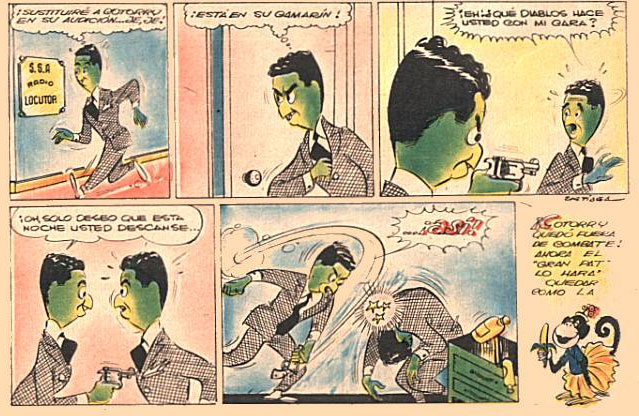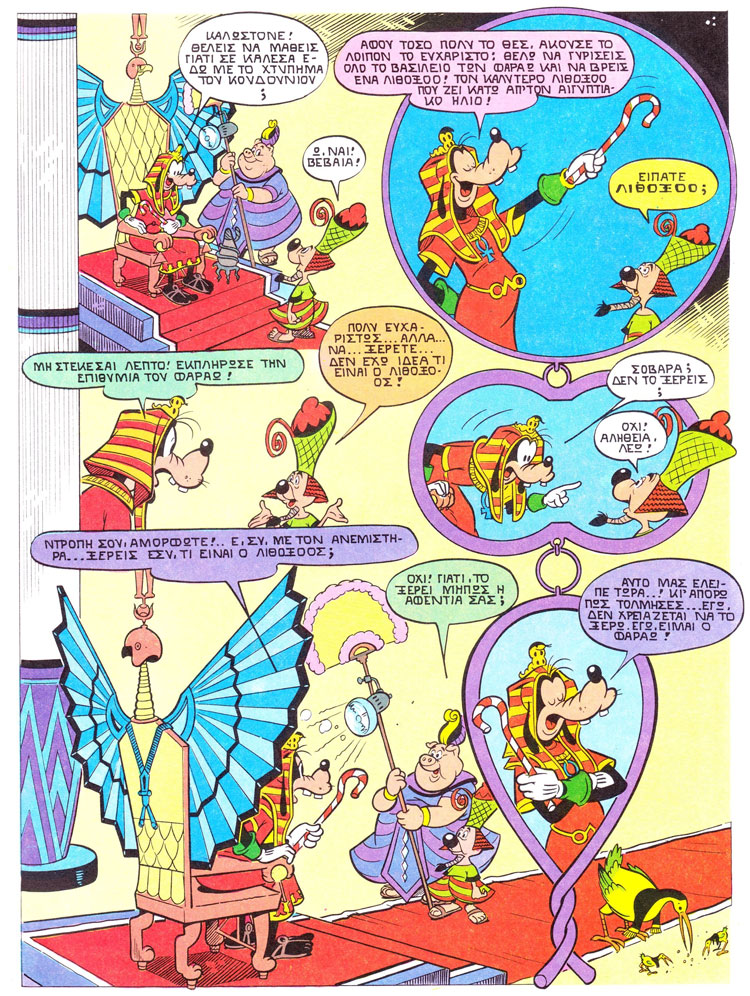'The Saga of Goofy Hercules' (1982) - © Disney.
Hector Adolfo de Urtiága - also referred to as Adolfo Hernando Urtiága - is an Argentinean comic artist, affiliated with the Jaime Diaz Studio. After drawing features for Argentinian comic magazines like Patoruzú and Mundo Infantil, and also for the Chilean publishing house Zig-Zag, he became known for his 1970s and 1980s work on international Disney comics. Urtiága notably drew long adventure parodies of historical figures and classic literature, starring the clumsy Disney dingo Goofy.
Early life
Sources differ about the artist's full name. Most international Disney-related sources list him as Hector Adolfo De Urtiága. In South American comic history, he is generally referred to as Adolfo Hernando Urtiága - or simply Adolfo Urtiága (and sometimes Alfonso Urtiága). He was born in 1927 in the Province of Córdoba and began his professional career making topical cartoons for the regional newspaper El Meridiano.
'Chupete, Mimosa y Pillin' (Mundo Infantil, 1953).
Dante Quinterno
At age 24, Urtiága moved to the Argentinean capital, Buenos Aires, where he began working for comic and children's magazines. As part of Dante Quinterno's art staff for the magazines Patoruzú and Las Correrías de Patoruzito, he drew stories with the superstrong Tehuelche Native American 'Patoruzú' - an iconic character of Argentinean comics - as well as its junior version 'Patoruzito'. He also contributed his own humor features to the Quinterno magazines, such as 'Los Tres Rechiflados' in Patoruzito and 'Tres Azotes' in Patoruzú, both starring foolish trios.
'El Chiflado Incognito' (PBT magazine, 19 November 1954). Translation: "Incognito told me how we can raise our salary!" - "You're not telling me stories, are you, friend?" - "No, he knows it from a good source."
Argentinian magazines
In Mundo Infantil, Urtiága created the poetic children's comic 'Chupete, Mimosa y Pillín' (1953), as well as the funny animal detective feature 'Picho de la Federal'. Other 1950s creations were 'El Chiflado Incognito' and 'Clavito va a cobrar... y Cobra!!!' in the satirical graphic humor magazine PBT and 'Recuerdos de Aniceto Villareal, Viejo capataz de Estancia' in Pica Rica. During the 1960s, he joined Grandes Aventuras de Don Nicola - a magazine by Héctor L. Torino - for which he was the first artist to draw 'Las Diabluras de Jaimito', a series about a mischievous boy, scripted by Franco Panzera. The Jaimito character later got its own title; by then his adventures were drawn by Horacio Saavedra and Francisco Mazza.
'Picho de la Federal' (Mundo Infantil, 1950s).
Chilean magazines
Starting in the mid-1950s, Adolfo Urtiága was also working extensively for the Chilean publishing house Zig-Zag. He was a regular contributor to the company's picaresque humor magazines, creating adult-oriented jokes with characters like 'Sexilia', 'Marylin Morrón', 'Frescolín', 'El Perro Latón', 'Querencio' and 'Envidiote' in El Pinguïno, as well as 'Saturnino' in Can-Can. Anonymously, he presumably also drew the El Pinguïno features 'Incógnito' and 'Clavito'. In 1965 and 1966, he was working for editor Themo Lobos in Zig-Zag's short-lived sci-fi humor magazine Rocket, drawing 'La Familia Clang' and 'Los Cucunautas'.
'Sexilia' (El Pinguïno, 1960s).
Jaime Diaz Studio
In 1975, Urtiága joined the Jaime Diaz Studio, a Buenos Aires-based art studio founded by animation artist Jaime Reyes Diaz. During the second half of the 1970s and throughout the 1980s, the team produced most of the artwork for the so-called "Studio Program" of the Walt Disney Company - a comic story production aimed at the company's international licensees. Urtiága was part of the original staff, along with pencilers Anibal Uzál, Cosme Quartieri and the brothers Horacio and Óscar F. Saavedra, as well as the inkers Robert Bat and Raul Barbéro. Working from scripts provided by U.S. writers and editors Carl Fallberg, Carson Van Osten and Cal Howard, the Jaime Diaz team for instance created most of the 'Mickey and The Sleuth' stories, a Sherlock Holmes parody series starring Mickey Mouse as the assistant of a Victorian age London detective.
'Christophorus Goofy Columbus' (1977) - © Disney. Greek translation.
Goofy Classics
Urtiága's main body of Disney work was for the 'Goofy Classics' series - stories in which Goofy plays the role of a famous historical or literary character. The first installments were five twelve-page stories published in Disney Magazine, created initially by Disney's U.S.-based staff, before the Jaime Diaz Studio took over. The concept caught on, and Disney decided to continue the idea by creating full-length stories of 44 pages long. Between 1976 and 1987, over thirty titles were made, published in books and magazines by Disney licensees all over the world. Notable for his dynamic and detailed artwork as well as his baroque panel lay-outs, Adolfo Urtiága served as the series' lead penciler, with Diaz colleague Rubén Torreiro inking most of his pages. The majority of the stories were scripted by Cal Howard; some others were written by Tom Yakutis, Greg Crosby or Carl Fallberg.
In each episode, the simple-minded dingo crawls into the skin of famous kings (Tutankamon), conquerors (Genghis Khan, Hannibal), painters (Leonardo da Vinci), explorers (Christopher Columbus, Marco Polo), composers (Ludwig von Beethoven, Johann Strauss) or scientists (Galileo Galilei, Archimedes, Benjamin Franklin). Mickey Mouse, Clarabella Cow and Pete often have supporting roles. Loosely based on true history, the stories are not educational. Most of the time, the plot deviates heavily from historical facts in favor of silly situations. In the Columbus story, for instance, Goofy and his crew never reach America. Instead, their ship tumbles off the edge of the world, because Earth turns out to be flat instead of round. The comics are also full of deliberate anachronisms and characters breaking the fourth wall. In the Galilei story, Goofy and Mickey try to obtain cardboard ducts from a sausage maker in order to make a telescope. When he doesn't want to sell them, Goofy begs him to reconsider, "because otherwise this story will be over too soon." Mickey also frequently complains that he barely has anything to say or do in the story.
'Goofy Quixote' (1982) - © Disney.
For the stories based on world literature, De Urtiága illustrated spoofs of Greek mythology ('King Midas', Hercules'), epic sagas ('The Odyssey', 'King Arthur'), fairy tales ('Aladdin'), adventure stories ('Robinson Crusoe', 'Around The World in 80 Days') and gothic horror ('Frankenstein'). Much like the history stories, the literary parodies rarely stay close to the source material. In Goofy's version of Homer's Odyssey, for instance, the dingo has to rely on cue cards to remember "his lines". Part of his shipping crew gets fired and is sent to an "unemployment boat". Later, when Goofy finds the other half of his crew swimming instead of guarding his ship, they defend themselves saying "because we haven't played a role in the story for 16 pages now, so we thought our part was over." A special case is Goofy's version of the Portuguese epic poem 'Os Lusiádas', a story largely unknown outside the Iberian peninsula. Since explorer Vasco da Gama has a prominent role in it, some countries ran it under the title 'Goofy as Vasco da Gama' instead. By 1987, De Urtiága retired from the 'Goofy Classics' series, and became art director of the Jaime Diaz Studio. Some of the later 'Goofy Classics' - first published in the late 1980s and early 1990s - had artwork by Anibal Uzál.
Later work
Adolfo Urtiága continued to work for the Jaime Diaz Studio until his retirement in the 1990s. Apart from the 'Goofy Classics', he was also one of the artists of the 'A Goofy Look At...' feature (1979-1983), in which Professor Goofy tries to explain the history of natural phenomena, arts, feelings, everyday objects and sports in four-page comic stories. In the second half of the 1980s, he participated in the production of the 'Disney Babies' stories, and in the 1990s, he penciled a couple of 'Aladdin' stories for Disney Adventures magazine.
Creative use of panel lay-outs in 'Goofy as Tut Anch Amon' (S78096) - © Disney. Greek translation.










